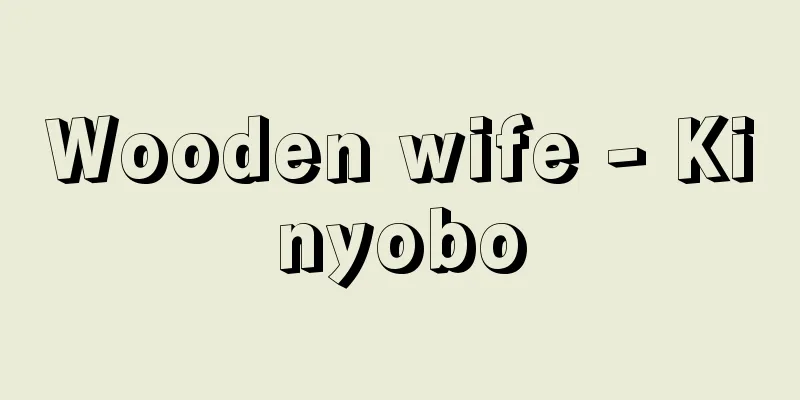Kineya Kisaburo - Kineya Kisaburo

|
...It is said to be the head family of Nagauta. It has been in existence for 15 generations up to now, but this does not only include the Rokuzaemon family, but also the family successors including the first Kangoro Kineya, who is said to be the founder of Kineya, such as Kineya Kangoro and Kineya Kisaburo. There are nine people under the Rokuzaemon family name, including the second, fourth, and ninth generations up to the 15th, but there are many doubts about the second and fourth generations, and there are also many unknowns about the sixth Kisaburo as the head family.... From "Nagauta"...The Kineya Keifu, compiled by Kineya Kangoro III, states that the first Kineya Kangoro, who went down to Edo in the Genna era (1615-24), was the founder of Kineya, and the third Kineya Kangoro (the third Kineya, and the second under the name Kineya Kangoro) was the founder of Choga shamisen, but there is no proof. The next stage, Yaro Kabuki, made rapid progress during the Genroku period (1688-1704), and dances were frequently performed during the intermissions of Tsuzuki Kyogen in addition to the general dances that were used to show the faces of the performers. Composers and shamisen players such as Kishino Jirozo and Yamamoto Kiichi appeared in Kamigata, and Kineya Kisaburo and Kineya Rokusaburo appeared in Edo. The accompanying music was originally called "short songs" or "uta," but from around the Genroku period it came to be called "long songs." *Some of the terminology that refers to "Kineya Kisaburo" is listed below. Source | Heibonsha World Encyclopedia 2nd Edition | Information |
|
…長唄の宗家といわれる。現在まで15代を数えるが,これは六左衛門のみの代数ではなく,杵屋の始祖といわれる初代勘五郎以後の杵屋勘五郎や杵屋喜三郎の名義をも含めた家督相続者の代数である。六左衛門名義としては,2代,4代,および9代以後15代までの9名を数えるが,2代,4代については疑わしい点も多く,また宗家としての6代喜三郎までについても,不明な点が多々ある。… 【長唄】より…3世杵屋(きねや)勘五郎編《杵屋系譜》では,元和年間(1615‐24)に江戸に下った初世杵屋勘五郎を杵屋の始祖とし,3代目杵屋勘五郎(杵屋の3代目であり,杵屋勘五郎名義では2世)を〈長哥三絃始祖〉としているが確証はない。次の野郎歌舞伎は元禄期(1688‐1704)を迎えて急速な進歩をとげ,顔見世的な総踊り以外に〈続き狂言〉の幕間にも舞踊が盛んに上演されるようになり,上方に岸野次郎三,山本喜市などの作曲者や三味線演奏者,江戸にも杵屋喜三郎,杵屋六三郎などが現れた。その伴奏音楽も最初は〈小うた〉〈うた〉などとも呼ばれていたが,元禄期ころからは〈長うた〉と呼ばれるようになった。… ※「杵屋喜三郎」について言及している用語解説の一部を掲載しています。 出典|株式会社平凡社世界大百科事典 第2版について | 情報 |
<<: "Kineya genealogy" - Kineya Keifu
>>: Kineya Kangoro (3rd generation)
Recommend
Kanuri people - Kanuri people (English spelling)
A tall black ethnic group living in the Bornu regi...
electro-cardiogram
Electrocardiograms, which record the electrical ph...
Opisthodomos (English spelling)
Architectural term. Aureole. A room at the rear of...
Romeo and Juliet
A ballet work. It consists of a prologue, three ac...
Unkintei
…His real surname was Yamamoto. He was appointed ...
Buddha Tooth Relic Festival
A festival held in Sri Lanka to honor the tooth of...
Sutra desk - Kyozukue
A desk used to place Buddhist scriptures and to r...
Coast Guard - English spelling: coast guard
A maritime force that enforces maritime law along ...
Escoffier, GA - Escoffier
… [history] From the mid-19th century onwards, la...
Repeat offender - Ruihan
This refers to a situation in which a sentence is...
Fatty acid - Shibosan (English spelling)
A chain-type carboxylic acid with one carboxyl gr...
Asahi Bemberg Silk Thread
…In 1929, Nippon Bemberg Silk Co., Ltd. was estab...
Dicaeum
…Some species sing, but their songs are relativel...
Şeyh Sait (English spelling) SeyhSait
In February 1925, the Kurds rebelled against Pres...
"Hokake Matsuru Iro no Ukiyoe" - A painting of a floating world
...Nagauta. One of the pieces in the original tit...









![Iheya [village] - Iheya](/upload/images/67cf6fc47222c.webp)